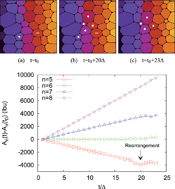Internal dynamics and activated processes in soft-glassy materials
Abstract
Plastic rearrangements play a crucial role in the characterization of soft-glassy materials, such as emulsions and foams. Based on numerical simulations of soft-glassy systems, we study the dynamics of plastic rearrangements at the hydrodynamic scales where thermal fluctuations can be neglected. Plastic rearrangements require an energy input, which can be either provided by external sources, or made available through time evolution in the coarsening dynamics, in which the total interfacial area decreases as a consequence of the slow evolution of the dispersed phase from smaller to large droplets/bubbles. We first demonstrate that our hydrodynamic model can quantitatively reproduce such coarsening dynamics. Then, considering periodically oscillating strains, we characterize the number of plastic rearrangements as a function of the external energy-supply, and show that they can be regarded as activated processes induced by a suitable “noise” effect. Here we use the word noise in a broad sense, referring to the internal non-equilibrium dynamics triggered by spatial random heterogeneities and coarsening. Finally, by exploring the interplay between the internal characteristic time-scale of the coarsening dynamics and the external time-scale associated with the imposed oscillating strain, we show that the system exhibits the phenomenon of stochastic resonance, thereby providing further credit to the mechanical activation scenario.


 Please wait while we load your content...
Please wait while we load your content...